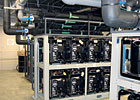
Compact chiller for medium temperature applications is part of sustainability efforts at a supermarket in Charlotte, N.C.
The Charlotte store, located at The Shoppes at Ardrey Kell, is the first in a Harris Teeter pilot program to implement the Second Nature Compact Chiller (SNCC) technology developed by Hill Phoenix.
Over the last couple of years, as part of ongoing discussions about refrigerant management, Michal Shepard, director of energy for Harris Teeter, sought a compact refrigeration technology that would reduce the initial refrigerant charge and the potential for leaks over the life of the equipment.
According to Shepard, “We asked Hill Phoenix to look at secondary refrigeration in a new way. Could they find or produce a refrigeration system that would simplify the typical secondary systems? Could they produce these systems as self-contained modules with small charges, no oil systems, and simplified controls that could be stacked together to give us the refrigeration rack-style efficiencies we have today?
“We also wanted as close to a nonfield-serviceable unit as possible.”
“We searched all over the world and were able to find similar technology being utilized in Sweden,” said Brad Schwichtenberg, vice president of business development for the manufacturer.
“We contacted the inventor and worked with him to create our proprietary Second Nature Compact Chiller units.”
DIFFERENCES
The new technology is a bit different from the standard Second Nature medium-temperature secondary refrigeration systems.The standard systems are air-cooled, parallel compressor systems connected to brazed plate heat exchangers that provide a chilled water and glycol mixture for cooling display cases and coolers.
The SNCC units have been designed to provide this same cooling effect by paralleling the hydronics side of the secondary system as opposed to the refrigeration side of the system. The units also use a water and glycol mixture as a condensing fluid for compressor heat rejection. This design allows a reduction in refrigerant charge. “The technology is simple,” said Schwichtenberg. “It’s like lining up several home refrigerators to make cold water.”
He noted that a unique feature of the design is the multichannel heat exchanger. The patented technology is actually three heat exchangers in one. One circuit is for cooling, another circuit is for condensing, and the third is a liquid subcooling circuit that also acts as a buffer between the cooling and condensing sections. In addition, the chiller units employ even-sized scroll compressors and are pre-charged.

Multi-channel heat exchanger is actually three heat exchangers in one with one circuit for cooling, a second for condensing, and a third as a liquid sub-cooling circuit.
REDUCTION OF CHARGES
Standard Second Nature medium-temperature systems are said to be able to reduce refrigerant required by 50 to 75 percent by eliminating refrigerant in long runs to case circuits around the store. Cooling at the display cases and coolers is achieved utilizing a 35 percent glycol solution that is delivered via loop piping.Because the medium-temperature secondary refrigerant is not under high pressure like a primary refrigeration direct expansion (DX) system, the Harris Teeter installation uses the Georg Fischer ABS plastic piping system instead of copper pipe.
Because the piping that contains HFC refrigerant for the SNCC units is measured in inches, the system is critically charged. The critical charge feature, combined with the new Hill Phoenix SmartValve™ electronic superheat management system, allows a charge of less than 8 pounds for a single unit, the company said. This further reduces refrigerant requirements and eliminates the need for excess amounts of refrigerant storage within the system that typically accommodates wide swings in ambient conditions.
Historically, a typical DX refrigeration installation (total low and medium temperature) at Harris Teeter required approximately 4,400 pounds of refrigerant. The Ardrey Kell installation requires approximately 1,200 pounds, the majority of which is utilized by the low-temperature systems. This is nearly a 73 percent reduction in total store refrigerant, officials said.
To break it down further, officials said, a medium-temperature system normally would require around 3,300 pounds of refrigerant. In the new store, the medium-temperature systems requires 100 pounds of refrigerant. The units were pre-charged at the factory.
If all goes according to plan with this first installation, a second installation will utilize Hill Phoenix Second Nature Compact Chiller units for both low- and medium-temperature applications. When this occurs, the total refrigerant reduction will be approximately 95 percent, it was reported.
LEAK ISSUES
As for leak potential, all refrigerant is confined to the machine room with SNCC units. As a result, leak potential is less than 1 percent, said Rick Rogers of Rogers Refrigeration, the installing contractor at the Harris Teeter store. He described the SNCC secondary coolant technology as the most effective way to reduce the amount of refrigerant in a supermarket to date.LOWER MAINTENANCE COSTS
Another advantage of the units is lower refrigeration maintenance cost, the company said. By using plug-and-play product architecture, the maintenance cost is reduced because the units can be either worked on in a nonemergency environment or returned to the factory for service.“There are no service ports on the refrigeration side. If there is ever a problem on the refrigeration side, units are simply replaced and returned to the factory,” Schwichtenberg said. Additionally, each unit has its own exclusive control system, which enables easier diagnostics, he said.
CASE CONSIDERATIONS
The new Harris Teeter store also employs Hill Phoenix Coolgenix™ dome cases for both meat and service seafood. The design of the cases accentuates the display of the product and extends product life, it was noted. The company said these were the first display cases designed for secondary coolant technology.For more information, visit www.hillphoenix.com.
Publication date:09/08/2008

Report Abusive Comment